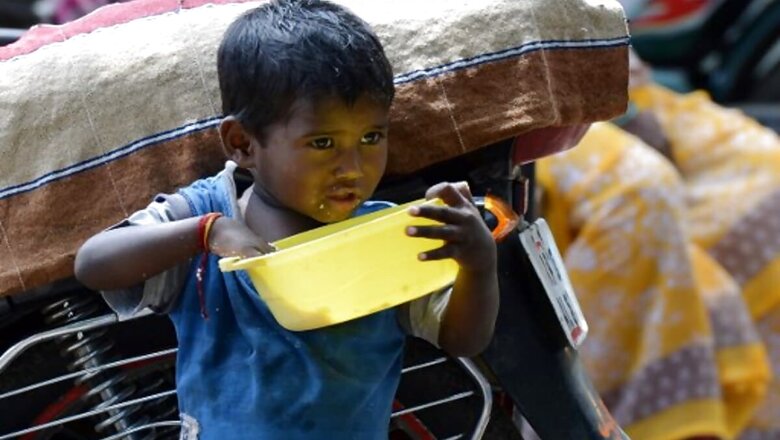
views
Mortality rate among infants and those under five years of age fell in 18 states and union territories out of a total 22 surveyed, while 16 of them registered a rise in the percentage of under-five children who are underweight and severely wasted, according to the fifth National Family Health Survey (NFHS-5). Health Minister Harsh Vardhan on Saturday released the fifth National Family Health Survey (NFHS) which contains detailed information on population, health, and nutrition for India and its states and Union Territories.
Thirteen states and UTs out of the 22 surveyed recorded a rise in the percentage of children under five years who are stunted in comparison to 2015-16, survey data showed. According to NFHS-5, Goa, Gujarat, Himachal Pradesh, Kerala, Maharashtra, Meghalaya, Mizoram, Nagaland, Telangana, Tripura, West Bengal, Lakshadweep and Dadra & Nagar Haveli and Daman and Diu recorded a rise in the percentage of children under five years who are stunted in comparison to NFHS-4 (2015-16).
Twelve states and UTs out of the 22 surveyed recorded a rise in the percentage of children under five years who are wasted in comparison to NFHS-4, while two states recorded the same percentage as in NFHS-4, the data showed. Assam, Bihar, Himachal Pradesh, Kerala, Manipur, Mizoram, Nagaland, Telangana, Tripura, Jammu and Kashmir, Ladakh and Lakshadweep showed a rise in the percentage of children under five years who are wasted, while Maharashtra and West Bengal had the same percentage, according to the data.
Sixteen states and UTs out of the 22 surveyed recorded a rise in the percentage of children under five years who are severely wasted and underweight in comparison to NFHS-4, the data showed. Andhra Pradesh, Assam, Bihar, Himachal Pradesh, Gujarat, Maharashtra, Manipur, Mizoram, Nagaland, Sikkim, Telangana, Tripura, West Bengal, Jammu and Kashmir, Ladakh and Lakshadweep showed a rise in the percentage of under-five children who are severely wasted, the data showed.
The NFHS-5 further showed that 20 states and UTs have recorded a rise in the percentage of children under 5 years who are overweight. According to the NFHS-5 (2019-20), sex ratio of the total population (females per 1,000 males) rose in 17 states and UTs in comparison to NFHS-4 (2015-16). The states which observed a drop in sex ratio of the total population were Himachal Pradesh, Kerala, Andaman and Nicobar Islands, Jammu and Kashmir and Ladakh. The neonatal mortality rate (NMR) (per 1,000 live births) dropped in 15 states and UTs in comparison to NFHS-4 (2015-16), while the infant mortality rate (IMR) and the under-five mortality rate (UMR) fell in 18 states and UTs, the NFHS-5 showed.
Maharashtra, Manipur, Meghalaya, Mizoram, Tripura, Andaman and Nicobar Islands and Dadra & Nagar Haveli and Daman & Diu recorded rise in NMR in comparison to NFHS-4 (2015-16). Manipur, Meghalaya, Tripura and Andaman and Nicobar Islands recorded rise in IMR and UMR in comparison to NFHS-4 (2015-16), it said.
The present NFHS is being conducted on 6.1 lakh sample households, involving household level interviews to collect information on population, health, family planning and nutrition related indicators. The results of 17 states and five UTs (Assam, Bihar, Manipur, Meghalaya, Sikkim, Tripura, Andhra Pradesh, Andaman and Nicobar Islands, Gujarat, Himachal Pradesh, Jammu & Kashmir, Ladakh, Karnataka, Goa, Maharashtra, Telangana, West Bengal, Mizoram, Kerala, Lakshadweep, Dadra Nagar Haveli and Daman & Diu) have been released now as Phase-I. Phase II covering the remaining 12 states and 2 UTs had their fieldwork suspended due to the COVID-19 pandemic, which has been resumed from November and is expected to be completed by May, 2021, the Health Ministry said in a statement.
The ministry said substantial improvement in maternal and child health indicators over NFHS-4 (2015-16) was recorded in the present survey. The fertility rate has further declined, contraceptive use has increased and unmet need has been reduced in most Phase I states, it said.
The survey found considerable improvement in vaccination coverage among children aged 12-23 months across all states/UTs. Women’s empowerment indicators, including women with bank account, also portray considerable progress, the Health Ministry said.
Read all the Latest News, Breaking News and Coronavirus News here




















Comments
0 comment